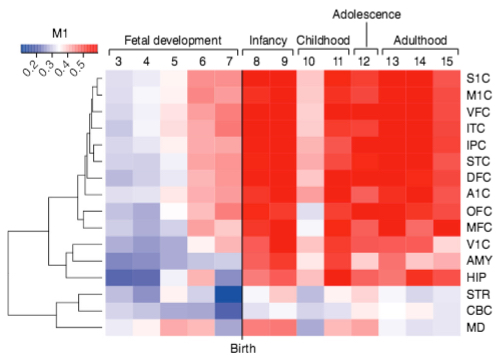Genetic ‘intelligence networks’ discovered in the brain
December 22, 2015

Color-coded heatmap of gradient of expression of the M1 gene network, spanning fetal development to late adulthood and expressed in distinct cortical regions (listed on right, such as primary somatosensory cortex, S1C). Most of the genes in this network express in cortical regions (indicated by red), except for the V1C (primary visual cortex), STR (striatum), CBC (cerebellar cortex), and MD (mediodorsal nucleus of thalamus) brain areas. (credit: Michael R. Johnson et al./Nature Neuroscience)
Scientists from Imperial College London have identified two clusters (“gene networks”) of genes that are linked to human intelligence. Called M1 and M3, these gene networks appear to influence cognitive function, which includes memory, attention, processing speed and reasoning.
Importantly, the scientists have discovered that these two networks are likely to be under the control of master regulator switches. The researcher want to identify those switches and see if they can manipulate them, and ultimately find out if this knowledge of gene networks could allow for boosting cognitive function.
“We know that genetics plays a major role in intelligence but until now, haven’t known which genes are relevant,” said Michael Johnson, lead author of the study from the Imperial College London Department of Medicine. Johnson says the genes they have found so far are likely to share a common regulation, which means it may be possible to manipulate a whole set of genes linked to human intelligence.
Combining data from brain samples, genomic information, and IQ tests
In the study, published in the journal Nature Neuroscience, the international team of researchers looked at samples of human brain from patients who had undergone neurosurgery for epilepsy. The investigators analyzed thousands of genes expressed in the human brain, and then combined these results with genetic information from healthy people who had undergone IQ tests and from people with neurological disorders such as autism spectrum disorder and intellectual disability.
Then they conducted various computational analyses and comparisons to identify the gene networks influencing healthy human cognitive abilities. Remarkably, they found that some of the same genes that influence human intelligence in healthy people cause impaired cognitive ability and epilepsy when mutated. And they found that genes that make new memories or sensible decisions when faced with lots of complex information also overlap with those that cause severe childhood onset epilepsy or intellectual disability.
“This study shows how we can use large genomic datasets to uncover new pathways for human brain function in both health and disease,” Johnson said. “Eventually, we hope that this sort of analysis will provide new insights into better treatments for neurodevelopmental diseases such as epilepsy, and ameliorate or treat the cognitive impairments associated with these devastating diseases.”
Abstract of Systems genetics identifies a convergent gene network for cognition and neurodevelopmental disease
Genetic determinants of cognition are poorly characterized, and their relationship to genes that confer risk for neurodevelopmental disease is unclear. Here we performed a systems-level analysis of genome-wide gene expression data to infer gene-regulatory networks conserved across species and brain regions. Two of these networks, M1 and M3, showed replicable enrichment for common genetic variants underlying healthy human cognitive abilities, including memory. Using exome sequence data from 6,871 trios, we found that M3 genes were also enriched for mutations ascertained from patients with neurodevelopmental disease generally, and intellectual disability and epileptic encephalopathy in particular. M3 consists of 150 genes whose expression is tightly developmentally regulated, but which are collectively poorly annotated for known functional pathways. These results illustrate how systems-level analyses can reveal previously unappreciated relationships between neurodevelopmental disease–associated genes in the developed human brain, and provide empirical support for a convergent gene-regulatory network influencing cognition and neurodevelopmental disease.